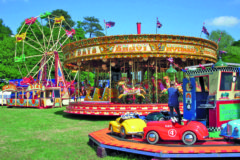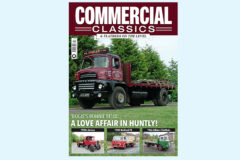Post-war fire engines
Posted by Chris Graham on 17th March 2021
Ron Henderson spotlights the most notable post-war fire appliances that were built on the successful Leyland chassis.

Post-war fire engines: The first Mastiff fire engine was commissioned by Bradford Fire Brigade in 1970, and is pictured here at the city’s Nelson Street Fire Station, in 1973. Bodied by Carmichael & Sons, and fitted with a Swedish 50-foot Orbitor hydraulic platform, this unique machine passed to the West Riding Fire Brigade in April 1974, and was withdrawn after just eight years of service.
Following on from the LAD-cabbed vehicles, Leyland’s next development in the heavy goods vehicle field was the smart Lynx, Beaver and Bison chassis, whose Ergomatic TGM cab was also featured on the group’s Albion and AEC vehicles. While the AEC Mercury versions were widely adopted by UK fire services, the Leyland models were not!

The City of Plymouth always had good-looking equipment. From 1967, the city commissioned eight Leyland Beaver fire engines, commencing with this Carmichael-bodied Leyland Lynx with 70-foot Simon hydraulic platform and in-built pump. In 1974, the fleet was incorporated into that of Devon County Fire Brigade.
Only three Lynxes saw service in the UK, which were a single pumping appliance each for Hartlepool and the City of Derby, plus one foam tender for the Northern Ireland Fire Authority. The Beavers were a little more successful, but not by much. Of the 14 examples adopted by UK fire brigades, the City of Plymouth Fire Brigade was the first customer, commissioning the first in 1967, which was fitted with a 70-foot Simon Snorkel hydraulic platform.
This brigade subsequently bought a further seven Beaver multi-purpose pumps, constructed by Carmichael & Sons of Worcester, with standard water tender bodies, but with the addition of foam-making capabilities and a comprehensive array of rescue equipment. St Helens. in Merseyside, also specified a 70-foot hydraulic platform on a Beaver chassis, but with an Orbitor hydraulic platform supplied by a Swedish company. This was accompanied by three water tenders based on Beaver chassis.
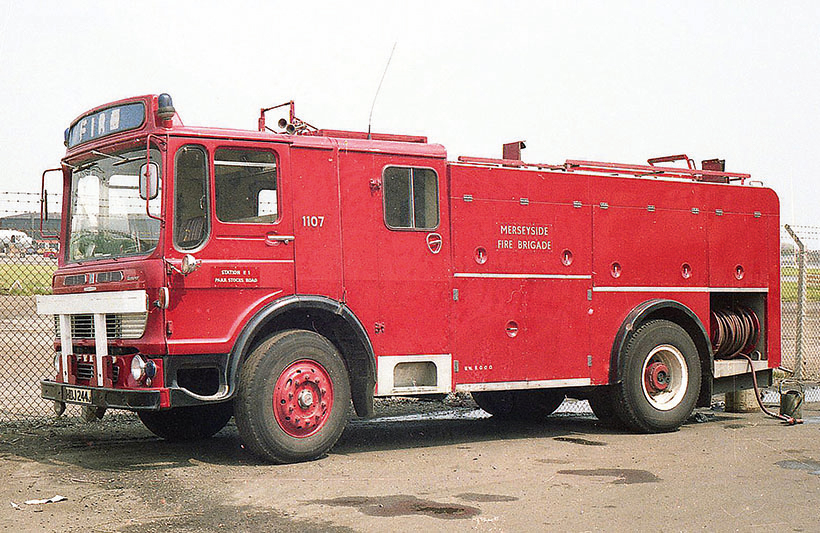
St Helens Fire Brigade operated four Leyland Beaver fire engines. Originally finished in a white livery with red trim, they were all repainted red when the brigade was incorporated into the Merseyside fleet. Pictured at the brigade’s workshops at Speke Airport, the substantial crash bar can be seen, as well as the innovative, oversized ‘FIRE’ sign.
These tenders were supplied by three different bodybuilders; the established, Worcester firm of Carmichael & Sons and two local firms, Woodwards of Formby and Cocker of Southport. These vehicles were unusual in being finished in a white livery, with a broad red stripe and trim. Following the fatal injury of a driver in a Swansea fire engine, which left the road while proceeding to a report of fire, the three pumps were subsequently fitted with a heavy crash bar on the front end.
The remaining two Beavers were both hydraulic-platform appliances, one with Orbitor booms for Merthyr Tydfil, and the other with Simon Engineering Snorkel booms for Hampshire. Barnsley bought an Ergomatic-cabbed emergency tender in 1971, finished in an overall yellow livery, which was a one-off as the chassis was a Super Comet.
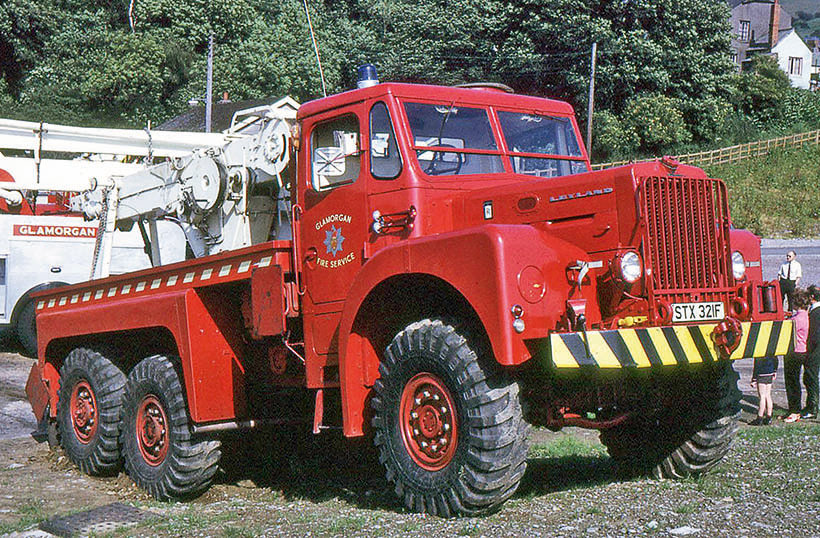
As well as the post-war Leylands commissioned from new, several other vehicles were acquired from former commercial operators, and adapted for fire service purposes. Particularly unusual was a pair of Martian FV1119, 10-ton 6×4 heavy recovery vehicles acquired from the Ministry of Defence. The first of the pair is seen with Glamorgan Fire Service, being put to good use righting an overturned fire engine. (Pic: The late John Hughes)
After this, things got a bit complex, with the former constituent chassis maker’s designs that were incorporated into the Leyland Group being badged as ‘Leylands’, such as the BMC FG and FJ models, which appeared under the Redline range. Of these new Laird, Boxer, Mastiff and similar designs, a few were adapted by British fire brigades, particularly as foam or water tankers. As for purpose-built fire engines, just two Mastiffs were adopted by UK fire brigades, although some others were built for overseas customers.
Bradford City Fire Brigade commissioned the first Mastiff in 1970; a smart, Carmichael-bodied combination pumping appliance with Swedish Orbitor 50-foot hydraulic platform. The next one came two years later, which had a van body-type emergency tender, for Nottingham City. As a departure from acquiring pre-owned tankers, Hampshire Fire Brigade bought four Mastiffs with tanker bodies, supplied by Fergusson.

Another pre-owned Leyland, a 1966 LAD Super Comet, which was 11 years old when Merseyside Fire Brigade workshops staff converted it from a petrol tanker, to a bulk-foam tender. Several other former fuel and milk tankers proved convenient resources for both public and private fire brigades.
In 1986, it was announced that, after an absence of 25 years, Leyland-DAF was to re-enter the fire service market, with a specially-developed version of the Freighter 16.17 truck chassis, seeking a substantial share of the 250 fire engines sold in the UK each year, together with the export potential. Adaptations of the standard design – to comply with fire service standards – consisted of a reduction of almost five inches in the frame height, automatic transmission, re-positioning of the rear axle and re-siting of the air reservoirs and fuel tank within the frame, to provide maximum locker space.
A Godiva 500-gallons-per-minute pump was fitted at the rear, with a water tank of 200-gallon capacity, but options were available for 400-gallon tanks and 1,000-gallons-per-minute pumps. Designed in conjunction with Lancashire County Fire Brigade, the first 26 went to that authority, all with bodywork by Fulton & Wylie, of Irvine. Further batches (totalling 30) brought the total of Lancashire’s Leyland Freighters to 56. Other brigades buying the Freighter pumps included neighbouring Greater Manchester Fire Brigade with 22, Buckinghamshire with five and Gloucestershire with seven.

One of just three Leyland Lynxes to see service in the UK. Derby City had the first in 1970. Initially equipped with a Merryweather 50-foot wheeled escape ladder, it’s shown here after the city’s fire engine fleet was incorporated into the county fleet. The County Borough of Hartlepool operated a similar vehicle, but without the wheeled escape ladder. (Pic: The late Alan Garside)
This was a good start but, by this time, Volvo had infiltrated the market in a big way, being joined shortly after by Scania, MAN and Mercedes. Currently, Lancashire County Fire Brigade continues with the vestiges of the Leyland Group, having updated its fleet with vehicles badged purely as DAF. The rest is history.
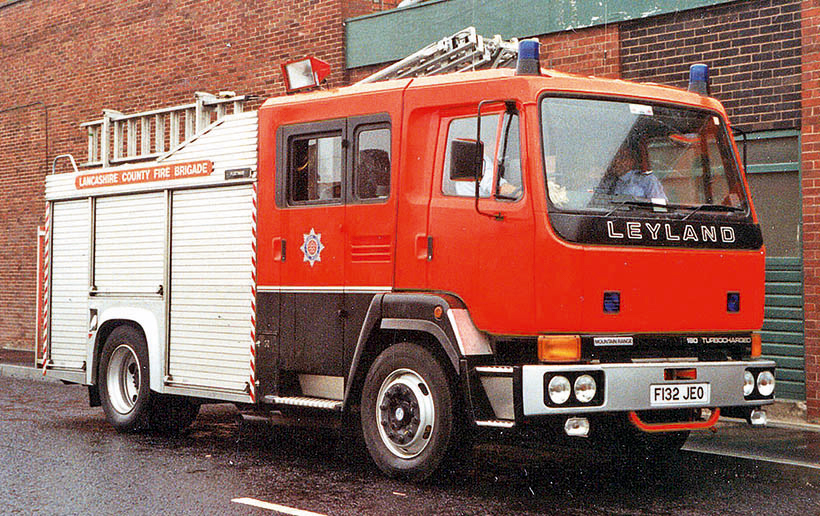
Lancashire County Fire Brigade was the first to adopt the Freighter chassis, ordering an initial batch of 26 in 1986, with bodywork by Fulton & Wylie, of Irvine. This one pictured at a rainy Southport, was part of a second batch and featured bodywork by short-lived Mountain Range Group of Crewe. The orange ‘day-glo’ livery showed up well on dull days.
For a money-saving subscription to Vintage Roadscene magazine, simply click here



